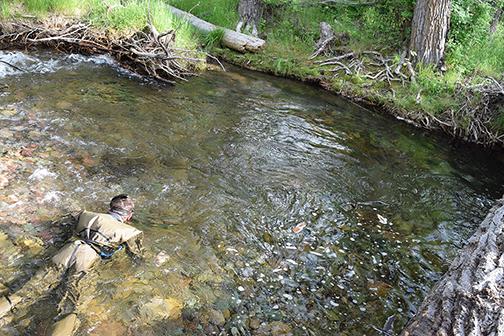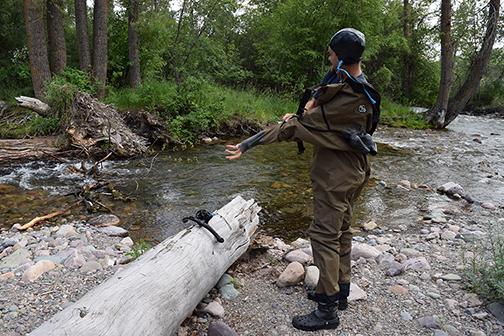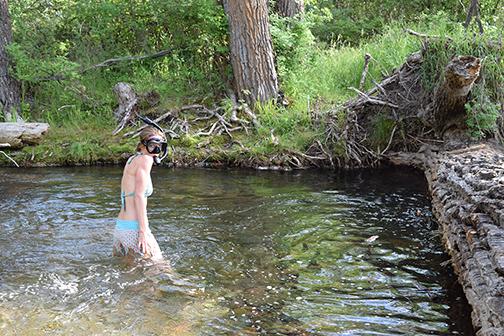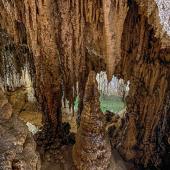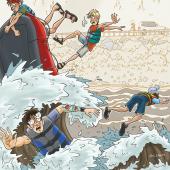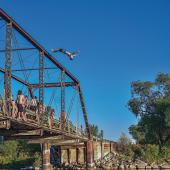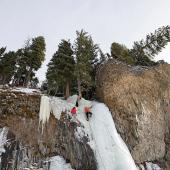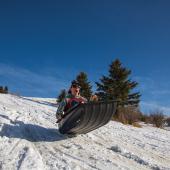Underwater World
River snorkeling in southwest Montana.
“Whoa, big fish,” my husband, Rob, exclaimed. We were halfway through an eight-day backpacking loop in the Absaroka-Beartooth Wilderness, and had stopped to rest. “Let’s see what they are.”
He skidded down to a cobble beach, whipped out a well-used snorkel and mask, and dove in naked. I followed more cautiously, and arrived just in time to hear, “It’s a school of rainbows!”
He tossed me the mask, and I dove in for my first-ever freshwater snorkel. I was immediately enveloped in a surreal, super-charged world. At least two dozen torpedo-shaped trout rushed around a glacier-green pool that seemed depthless. As an avid angler, sailor, packrafter, and hiker-of-riverside-trails, I’m no stranger to watery exploits. But I'd always thought snorkeling went hand-in-hand with tropical islands in exotic locales. That first up-close encounter changed my tune—it was magical.
Snorkeling brought a new intimacy to my relationship with rivers and creeks that running rapids or matching the hatch never could. There’s the muffled silence, marred only by the slow gurgle of water tumbling over stone; the dull hiss of sediment scratching its way downstream; and the slanting rays of afternoon sun, bouncing off cobbles and fish scales that appear super-sized (thanks to the 33% magnification effect of wearing a mask underwater). Motion becomes your sixth sense, and your breath the metronome that anchors you in the current.
Now I’m not about to give up my other water hobbies anytime soon, but river snorkeling has become a welcome addition to my water-sport quiver. A quick dip with a mask can add character to a day hike or turn a raft into an exploratory platform, where I pretend I’m the Rocky Mountain incarnation of Jacques Cousteau. Rob and I are not alone in our love affair with snorkeling: it’s becoming a popular pasttime all across the West, partly because it’s an easy-access, few-skills-necessary sport that’s fun for the whole family.
In fact, “snorkeling” is a bit of a misnomer, as all you really need to become one with the fish is a pair of goggles and the ability to hold your breath. This is especially true when swimming in large, wide rivers like the Madison, which can top 70 degrees, making for a relaxing environment while you peer around boulders and investigate pocket eddies. On the other hand, most of western Montana’s waterways are bone-chillingly cold, even on the most sweltering summer days. Snorkeling in high-mountain streams can take your breath away, as the water squeezes the air from your diaphragm with an icy punch. Wearing a wetsuit will extend your time in the water, but a drysuit is better at keeping the shiver-factor away. Regardless of whether your nude or fully neoprened, it’s wise to wear good river shoes and leave the fins at home, in case you’re stuck hopping a sudden logjam or traversing slippery boulders. Our hometown waters offer a variety of snorkeling venues, from placid pools on meandering rivers, to rapids that up the ante and the adrenaline. Take “Fishman” Mike Kasic, a river swimmer and snorkeling aficionado who lives in Livingston and regularly looks beneath the Yellowstone for cutthroat trout. Kasic’s underwater whitewater runs through Yankee Jim Canyon were featured in this BBC-produced video. Inspiring stuff, although I plan to stick to Class I waters myself.
Pat Byorth, Trout Unlimited’s Western Water Project director and previously a state fisheries biologist, agrees that the Yellowstone is a fun place to snorkel once spring runoff clears. He also recommends the upper Big Hole and the upper Madison, particularly above reaches with heavy boat traffic. If you can access them, spring creeks are prime spots for underwater viewing. According to Byorth, the best time to snorkel is between 10am and 2pm to maximize the most light penetration underwater. Summer is obviously the best season, but die-hards snorkel year-round.
Once you’re in the river, it’s all about patience and adjusting to a new perspective, like looking at one of those 3-D pictures that were popular in the ‘90s. Once your river-vision locks in, a whole new world comes alive. Stay in one spot, holding onto a rock or root and letting the river pass you by, or if the current is too strong and you feel like going with the flow, bob downstream watching fish dart out your path. Regardless of your pace, the rivers in southwest Montana are full of life, from the 20-inch rainbows and cutthroats hanging in feeding lanes, to the gossamer caddis larvae, firmly ensconced in protective casings of sticks and stones.
Get the Gear
Dirtbag Packing List:
Swimsuit and goggles
Bare feet
Sense of adventure
Mid-Range Set-Up:
Mask and snorkel: we like Cressi gear, which you can order on Amazon, but everyone’s face fits masks differently.
River shoes: Chacos or Tevas work well, though we like the basic Croc, too. Neoprene boots are another option to add some warmth and give you some traction.
Wetsuit: a shorty works well for quick trips, or the full shebang with gloves and hood are better for extended viewing.
Deluxe Gear:
Mask and snorkel: personalized set-up from Sports Cove off Huffine Lane.
Dry suit: OS Systems makes a drysuit specifically for freshwater exploration, or a kayaking drysuit by NRS or Kokatat will also work. Drysuits are often worn with felt-soled or studded wading boots, and a fleece underlayer.
Underwater camera: the Panasonic Lumix DMC TS4 (waterproof and shockproof) continues to withstand whatever we throw at it in Montana and beyond. GoPro cameras with the waterproof housing are great for underwater video, but a little less user-friendly for stills.

